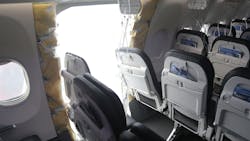FAA Grounds Boeing 737 MAX 9s
The FAA has ordered the temporary grounding of certain Boeing 737 MAX 9 aircraft operated by U.S. airlines. This is following a Jan. 5 incident on Alaska Airlines Flight 1282 where a door plug dislodged from the aircraft at roughly 16,000 feet and several passengers sustained injuries.
“The FAA is requiring immediate inspections of certain Boeing 737 MAX 9 planes before they can return to flight,” FAA Administrator Mike Whitaker said. “Safety will continue to drive our decision-making as we assist the NTSB’s investigation into Alaska Airlines Flight 1282.”
The Emergency Airworthiness Directive (EAD) requires operators to inspect affected aircraft before further flight. The required inspections will take around four to eight hours per aircraft, according to the FAA’s statement.
The FAA estimates 171 airplanes worldwide will be affected by the EAD.
On Sunday night, Alaska Airlines, waiting for airworthiness directive (AD) inspection criteria from the FAA, said its “maintenance teams are prepared and ready to preform the required inspections of the mid exit door plugs on its 737-9 MAX fleet.”
Shortly after the incident, Alaska Airlines CEO Ben Minicucci announced the airline had taken the precautionary step of temporarily grounding its fleet of 65 Boeing 737-9 aircraft.
The airline further noted, “The 737-9 MAX grounding has significantly impacted our operation. We have canceled 170 Sunday flights and 60 cancellations for Monday, with more expected. Cancellations will continue through the first half of the week, and we encourage guests with travel plans to continue to check their email and alaskaair.com for updates.”
Alaska Airlines reported the aircraft involved in Flight 1282 was delivered on Oct. 31, 2023. Specifically, the airline said the part of the aircraft involved in this event is a specific panel of the fuselage near the rear of the aircraft (a door plug).
At noon, Jan. 6, prior to the FAA temporary grounding, Alaska Airlines reported: “Of the 65 737-9 aircraft in our fleet, it was determined that 18 had in-depth and thorough [door plug] inspections performed as part of a recent heavy maintenance visit. These 18 aircraft were cleared to return to service today.”
By 6 p.m. Jan. 6, the National Transportation Safety Board (NTSB) assumed the lead role in the investigation. Alaska’s safety and technical teams, along with representatives from Boeing, are closely involved in supporting the NTSB. The 18 737-9 MAX Alaska Airlines aircraft that had received in-depth inspections as part of heavy maintenance checks were pulled from service until details about possible additional maintenance work are confirmed with the FAA, after Alaska received the FAA’s EAD.
In a Jan. 7 NTSB press conference, NTSB Chair Jennifer L. Homendy, emphasized “door plug” is the correct term. “It is not a door because it’s not usable,” she said.
NTSB structures team on Twitter shared a diagram of the door plug and components. “We wanted to show the door plug, the structure of the airframe and the components to help everyone understand what the structure looked like,” Homendy said.
Homendy said the structures team will look at “everything” on the door: “all of the components… to look at witness marks… paint transfer – what shape the door was in when it was found can tell them a lot about what occurred.”
Boeing is assisting in the investigation, stating: ““Safety is our top priority and we deeply regret the impact this event has had on our customers and their passengers. We agree with and fully support the FAA's decision to require immediate inspections of 737-9 airplanes with the same configuration as the affected airplane. In addition, a Boeing technical team is supporting the NTSB's investigation into the Jan. 5 accident. We will remain in close contact with our regulator and customers.”
Spirit AeroSystems, a significant supplier to Boeing, specializing in the manufacture of key components for various Boeing aircraft models, said they will continue to work together with Boeing on this matter.
“Spirit is following the protocols set by the regulatory authorities that guide communication in these types of circumstances and we will share further information when appropriate,” the company said.
Last year, faulty parts delivered by Spirit AeroSystems hampered 737 Max production. The issue was with incorrectly attached fittings that join the AFT fuselage to the vertical tail.
Additionally, Aircraft Mechanics Fraternal Association (AMFA) dispatched its Accident Investigation Team (AIT) to PDX. In a statement released Jan. 6, AMFA national president Bret Oestreich said:
“AMFA AIT Representatives will work with Alaska Airlines, Boeing, and potentially as a party with the National Transportation Safety Board (NTSB) investigation team to determine the probable cause. The goal of AMFA in assisting the NTSB with this investigative process is to utilize our expertise to discover the exact cause of this event and to identify solutions to prevent it from occurring in the future. AMFA leadership is maintaining constant communication with our AIT to support their activity during this ongoing investigation."
EASA Response
The European Union Aviation Safety Agency has adopted the EAD issued by the FAA for a specific configuration of the Boeing 737-9 (MAX).
EASA took the decision to adopt the FAA EAD despite the fact that, to the agency's knowledge and also on the basis of statements from the FAA and Boeing, no airline in an EASA Member State currently operates an aircraft in the relevant configuration. In the specific set-up covered by the EAD, a mid-cabin exit is replaced by a plug-in panel. This configuration is typically adopted by airlines flying lower-density operations (with lower passenger capacity) where this additional exit is not required to meet evacuation safety requirements.
The 737-9 aircraft operating in Europe do not have this configuration and are therefore not grounded by the EAD and can continue to operate normally.
EASA is in contact with the FAA on this matter and will follow the investigation into the Alaska Airlines event closely.
Copa Airlines Response
Copa Airlines informs that, following the Airworthiness Directive issued by the FAA, it has temporarily suspended the operations of 21 737 MAX9 aircraft, as per the mentioned directive, until they undergo the required technical inspection.
About the Author
Rebecca Kanable
Assistant Editor
Rebecca Kanable, a veteran journalist, worked with Endeavor Business Media's aviation group from 2021 to 2024 as assistant editor of Airport Business, AMT and Ground Support Worldwide. She previously worked for various publications, including trade magazines and newspapers.
Walker Jaroch
Editor
Contact: Walker Jaroch
Editor | AMT
+1-920-568-8399
>> To download the AviationPros media kits, visit: Marketing Resource Center
>>Check out our aviation magazines: Ground Support Worldwide | Airport Business | Aircraft Maintenance Technology


